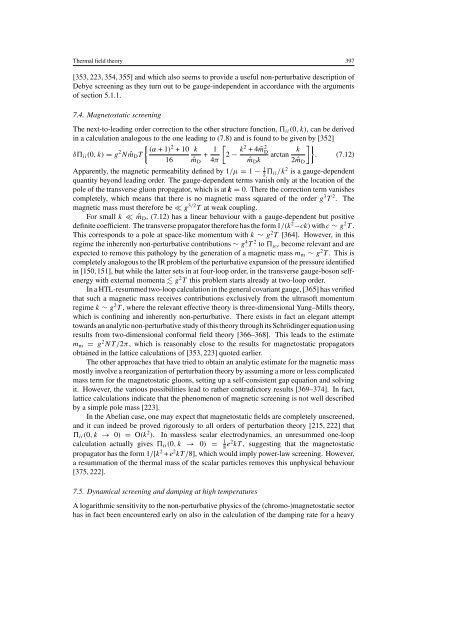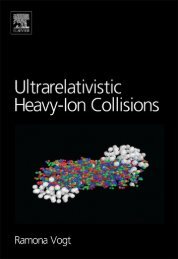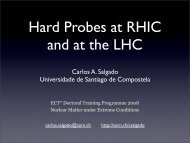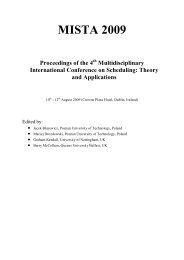Advances in perturbative thermal field theory - Ultra-relativistic ...
Advances in perturbative thermal field theory - Ultra-relativistic ...
Advances in perturbative thermal field theory - Ultra-relativistic ...
Create successful ePaper yourself
Turn your PDF publications into a flip-book with our unique Google optimized e-Paper software.
Thermal <strong>field</strong> <strong>theory</strong> 397<br />
[353, 223, 354, 355] and which also seems to provide a useful non-<strong>perturbative</strong> description of<br />
Debye screen<strong>in</strong>g as they turn out to be gauge-<strong>in</strong>dependent <strong>in</strong> accordance with the arguments<br />
of section 5.1.1.<br />
7.4. Magnetostatic screen<strong>in</strong>g<br />
The next-to-lead<strong>in</strong>g order correction to the other structure function, ii (0,k), can be derived<br />
<strong>in</strong> a calculation analogous to the one lead<strong>in</strong>g to (7.8) and is found to be given by [352]<br />
{ (α +1)<br />
δ ii (0,k)= g 2 2 +10 k<br />
N ˆm D T<br />
+ 1 [<br />
2 − k2 +4ˆm 2 D<br />
arctan<br />
k ]}<br />
. (7.12)<br />
16 ˆm D 4π ˆm D k 2 ˆm D<br />
Apparently, the magnetic permeability def<strong>in</strong>ed by 1/µ = 1 − 1 2 ii/k 2 is a gauge-dependent<br />
quantity beyond lead<strong>in</strong>g order. The gauge-dependent terms vanish only at the location of the<br />
pole of the transverse gluon propagator, which is at k = 0. There the correction term vanishes<br />
completely, which means that there is no magnetic mass squared of the order g 3 T 2 . The<br />
magnetic mass must therefore be ≪ g 3/2 T at weak coupl<strong>in</strong>g.<br />
For small k ≪ ˆm D , (7.12) has a l<strong>in</strong>ear behaviour with a gauge-dependent but positive<br />
def<strong>in</strong>ite coefficient. The transverse propagator therefore has the form 1/(k 2 −ck) with c ∼ g 2 T .<br />
This corresponds to a pole at space-like momentum with k ∼ g 2 T [364]. However, <strong>in</strong> this<br />
regime the <strong>in</strong>herently non-<strong>perturbative</strong> contributions ∼ g 4 T 2 to µν become relevant and are<br />
expected to remove this pathology by the generation of a magnetic mass m m ∼ g 2 T . This is<br />
completely analogous to the IR problem of the <strong>perturbative</strong> expansion of the pressure identified<br />
<strong>in</strong> [150,151], but while the latter sets <strong>in</strong> at four-loop order, <strong>in</strong> the transverse gauge-boson selfenergy<br />
with external momenta g 2 T this problem starts already at two-loop order.<br />
In a HTL-resummed two-loop calculation <strong>in</strong> the general covariant gauge, [365] has verified<br />
that such a magnetic mass receives contributions exclusively from the ultrasoft momentum<br />
regime k ∼ g 2 T , where the relevant effective <strong>theory</strong> is three-dimensional Yang–Mills <strong>theory</strong>,<br />
which is conf<strong>in</strong><strong>in</strong>g and <strong>in</strong>herently non-<strong>perturbative</strong>. There exists <strong>in</strong> fact an elegant attempt<br />
towards an analytic non-<strong>perturbative</strong> study of this <strong>theory</strong> through its Schröd<strong>in</strong>ger equation us<strong>in</strong>g<br />
results from two-dimensional conformal <strong>field</strong> <strong>theory</strong> [366–368]. This leads to the estimate<br />
m m = g 2 NT/2π, which is reasonably close to the results for magnetostatic propagators<br />
obta<strong>in</strong>ed <strong>in</strong> the lattice calculations of [353, 223] quoted earlier.<br />
The other approaches that have tried to obta<strong>in</strong> an analytic estimate for the magnetic mass<br />
mostly <strong>in</strong>volve a reorganization of perturbation <strong>theory</strong> by assum<strong>in</strong>g a more or less complicated<br />
mass term for the magnetostatic gluons, sett<strong>in</strong>g up a self-consistent gap equation and solv<strong>in</strong>g<br />
it. However, the various possibilities lead to rather contradictory results [369–374]. In fact,<br />
lattice calculations <strong>in</strong>dicate that the phenomenon of magnetic screen<strong>in</strong>g is not well described<br />
by a simple pole mass [223].<br />
In the Abelian case, one may expect that magnetostatic <strong>field</strong>s are completely unscreened,<br />
and it can <strong>in</strong>deed be proved rigorously to all orders of perturbation <strong>theory</strong> [215, 222] that<br />
ii (0,k → 0) = O(k 2 ). In massless scalar electrodynamics, an unresummed one-loop<br />
calculation actually gives ii (0,k → 0) =<br />
1 8 e2 kT , suggest<strong>in</strong>g that the magnetostatic<br />
propagator has the form 1/[k 2 + e 2 kT/8], which would imply power-law screen<strong>in</strong>g. However,<br />
a resummation of the <strong>thermal</strong> mass of the scalar particles removes this unphysical behaviour<br />
[375, 222].<br />
7.5. Dynamical screen<strong>in</strong>g and damp<strong>in</strong>g at high temperatures<br />
A logarithmic sensitivity to the non-<strong>perturbative</strong> physics of the (chromo-)magnetostatic sector<br />
has <strong>in</strong> fact been encountered early on also <strong>in</strong> the calculation of the damp<strong>in</strong>g rate for a heavy







